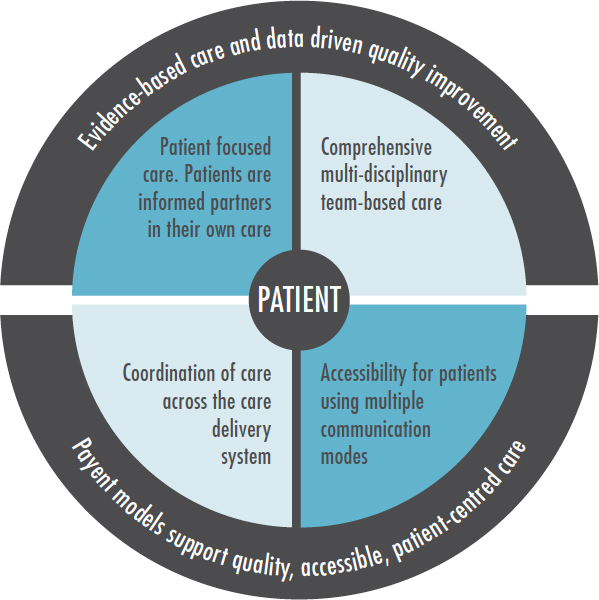
Time to match health care with the consumer needs of the 21st Century
Health and consumer leaders have released a blueprint for 21st Century Medicare aimed at giving patients greater say in a team-based health care system.
The report (PDF 189KB) resulting from an expert Roundtable earlier this month recommends stepping up Federal Government Health Care Home plans in order to drive a fundamental shift in Australia’s health services toward patient-focused, community based health care “hubs” coordinating care.
The hubs, integrated with hospitals, specialists, allied health and community-based services would offer a one-stop shop, providing patients with more individualised attention including on-line access to their own health information, tests and appointment bookings.
The Roundtable was hosted by the Consumers Health Forum of Australia, the Royal Australian College of General Practitioners (RACGP), The George Institute for Global Health and the Menzies Centre for Health Policy.
In a joint statement released today, the Roundtable group has urged Federal, state and territory governments to expand and accelerate development of the existing Health Care Homes project, planned to trial coordinated care for chronically-ill patients in up to 200 sites.
“We live in a highly connected world yet too often health care, which relies so heavily on communication of patient information, remains disconnected.
“Instead of patients being passive recipients of care from general practitioners alone, we need to build on the Health Care Homes plan to develop a Patient-Centred Health Care Home system that would support patients being active partners in their care. It would aim to give individuals say in comprehensive services involving nurses and other health practitioners working with GPs to provide right care at the right time.
“The current fee for service system encourages high patient volumes but not high quality care or team work with other health professionals. We need to develop new ways of remunerating health practitioners on the basis of the quality and effectiveness of their care,” the Roundtable group said.

The key elements of the Patient-Centred Healthcare Homes and how it supports the patient.
Among the 22 recommendations the Roundtable has made for reform are:
- Implement changes to enable assessment and provision of care through a mix of face to face, phone and email consultations with GPs, practice nurses and other care team members.
- Support patients to be active members of the health care team and to monitor their care experience
- Design a payment system to support patient-centred health care homes, that is quality-focused, rewards effective care, accounts for rurality and socio-economic disadvantage and avoids adverse incentives like under-treatment, cost-shifting and cream skimming.
Leanne Wells, Chief Executive Officer of the Consumers Health Forum said:
“Better patient experience makes better patients. We can achieve this in Australia by rethinking health care so that the system is not structured around provider priorities but rather ensures the patient is at the centre of decision-making in a coordinated system.
“Roundtable participants agreed that positive patient experience, such as reduced waiting times and streamlined services would improve outcomes particularly for those who have experienced poorer access to care.
“Governments need to realise that not only will this change mean happier and healthier communities it also stands to deliver better outcomes for the economy, frequently replacing expensive hospital stays with more effective, less expensive care in the community.
“Contemporary realities demand vigorous and sustained national leadership and significant government investment to develop these health care hubs,” Ms Wells said.
"The Government’s Health Care Homes trials plan is an encouraging start. The focus on chronic care and GP-based services is clearly a priority but reforms need to go community-wide." Professor Stephen Jan, The George Institute for Global Health
The President of the RACGP, Dr Frank R Jones, said:
“The Australian health care system is being challenged by a new health demography. We can either struggle on with a 1980s health system that does little to confront realities such as consumer demand and the growing challenge of chronic disease, or take concrete steps towards driving changes that reflect 21st century knowledge in health care management and information technology.
“Rather than the doctor taking sole responsibility for the care of the patient, the patient and the health care hub team would work in a partnership supported by a centre and service co-designed with consumers and patients.
"The GP will continue to lead primary medical care, but in addition the patient would have access to better integrated care, coordinated and tailored to their needs. Common chronic illnesses like diabetes require a range of different practitioners but at present these are either not available and/or poorly integrated,” Dr Jones said.
Professor Stephen Jan, from The George Institute for Global Health, said:
“The Government’s Health Care Homes trials plan is an encouraging start. The focus on chronic care and GP-based services is clearly a priority but reforms need to go community-wide.
“No doubt, these will involve significantly more government funding. Developing payment and performance measures and a comprehensive evidence-based approach would generate a more cost effective system,” Professor Jan said.
Associate Professor James Gillespie of the Menzies Centre for Health Policy at the University of Sydney said: “These reforms require a major cultural shift and large-scale transformational change that build on Medicare’s principles of universal coverage and simplicity to capture the potential of health care available in the 21st century.
“We should adopt an evolutionary, staged approach as success will depend on good will and collaboration as well as significant investment and change management.
“If we are to transform primary health care this century, the right time is now to begin implementing approaches we already know work well from experience here and overseas,” Professor Gillespie said.



